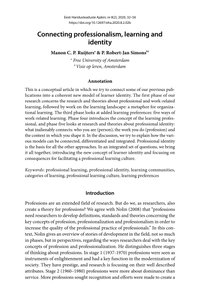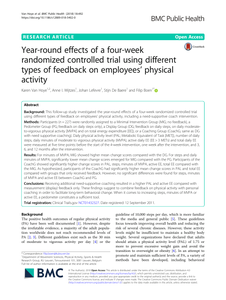Background:An eHealth tool that coaches employees through the process of reflection has the potential to support employees with moderate levels of stress to increase their capacity for resilience. Most eHealth tools that include self-tracking summarize the collected data for the users. However, users need to gain a deeper understanding of the data and decide upon the next step to take through self-reflection.Objective:In this study, we aimed to examine the perceived effectiveness of the guidance offered by an automated e-Coach during employees’ self-reflection process in gaining insights into their situation and on their perceived stress and resilience capacities and the usefulness of the design elements of the e-Coach during this process.Methods:Of the 28 participants, 14 (50%) completed the 6-week BringBalance program that allowed participants to perform reflection via four phases: identification, strategy generation, experimentation, and evaluation. Data collection consisted of log data, ecological momentary assessment (EMA) questionnaires for reflection provided by the e-Coach, in-depth interviews, and a pre- and posttest survey (including the Brief Resilience Scale and the Perceived Stress Scale). The posttest survey also asked about the utility of the elements of the e-Coach for reflection. A mixed methods approach was followed.Results:Pre- and posttest scores on perceived stress and resilience were not much different among completers (no statistical test performed). The automated e-Coach did enable users to gain an understanding of factors that influenced their stress levels and capacity for resilience (identification phase) and to learn the principles of useful strategies to improve their capacity for resilience (strategy generation phase). Design elements of the e-Coach reduced the reflection process into smaller steps to re-evaluate situations and helped them to observe a trend (identification phase). However, users experienced difficulties integrating the chosen strategies into their daily life (experimentation phase). Moreover, the identified events related to stress and resilience were too specific through the guidance offered by the e-Coach (identification phase), and the events did not recur, which consequently left users unable to sufficiently practice (strategy generation phase), experiment (experimentation phase), and evaluate (evaluation phase) the techniques during meaningful events.Conclusions:Participants were able to perform self-reflection under the guidance of the automated e-Coach, which often led toward gaining new insights. To improve the reflection process, more guidance should be offered by the e-Coach that would aid employees to identify events that recur in daily life. Future research could study the effects of the suggested improvements on the quality of reflection via an automated e-Coach.
DOCUMENT

This article describes the relation between mental health and academic performance during the start of college and how AI-enhanced chatbot interventions could prevent both study problems and mental health problems.
DOCUMENT

Quantifying measures of physical loading has been an essential part of performance monitoring within elite able-bodied sport, facilitated through advancing innovative technology. In wheelchair court sports (WCS) the inter-individual variability of physical impairments in the athletes increases the necessity for accurate load and performance measurements, while at the same time standard load monitoring methods (e.g. heart-rate) often fail in this group and dedicated WCS performance measurement methods are scarce. The objective of this review was to provide practitioners and researchers with an overview and recommendations to underpin the selection of suitable technologies for a variety of load and performance monitoring purposes specific to WCS. This review explored the different technologies that have been used for load and performance monitoring in WCS. During structured field testing, magnetic switch based devices, optical encoders and laser systems have all been used to monitor linear aspects of performance. However, movement in WCS is multidirectional, hence accelerations, decelerations and rotational performance and their impact on physiological responses and determination of skill level, is also of interest. Subsequently both for structured field testing as well as match-play and training, inertial measurement units mounted on wheels and frame have emerged as an accurate and practical option for quantifying linear and non-linear movements. In conclusion, each method has its place in load and performance measurement, yet inertial sensors seem most versatile and accurate. However, to add context to load and performance metrics, position-based acquisition devices such as automated image-based processing or local positioning systems are required.
DOCUMENT

Higher educational institutions incorporate projects into their curricula, in which students, together with educators, researchers and professionals from practice, try to find solutions for real, societal problems, to develop relevant skills. Because such solutions are increasingly digital with high impact on society, ethical responsibility is an important part of these skills. In this study, we analyze two cases of digital innovation projects in higher education in which the concept of the Ethical Matrix is adapted and integrated in a Value Sensitive Design approach and applied by educators (case 1) and by students (case 2). We find that an adapted version of the Ethical Matrix supports educators and students in taking values of different types of stakeholders into account which leads to different design choices.
MULTIFILE

This paper reports on CATS (2006-2007), a project initiated by the Research Centre Teaching in Multicultural Schools, that addresses language related dropout problems of both native and non-native speakers of Dutch in higher education. The projects main objective is to develop a model for the redesign of the curriculum so as to optimize the development of academic and professional language skills. Key pedagogic strategies are the raising of awareness of personal proficiency levels through diagnostic testing, definition of linguistic demands of curriculum tasks, empowerment of student autonomy and peer feedback procedures. More specifically, this paper deals with two key areas of the project. First, it describes the design and development of web-based corpus software tools, aimed at the enhancement of the autonomy of students academic reading and writing skills. Secondly, it describes the design of three pilots, in which the process of a content and language integrated approach - facilitated by the developed web tools - was applied, and these pilots respective evaluations. The paper concludes with a reflection on the project development and the experiences with the pilot implementations.
DOCUMENT

This paper reports on the EU-project 'Professionally Networking Education and Teacher Training' (PRONETT). The key objective of the PRONETT project (2001-2004) is to develop a regional and cross national learning community of pre- and in-service teachers and teacher educators supported by webbased resources and tools to collaborate and to construct shared understandings of teaching and learning in a networked classroom. The reasons for the initiative and the design principles of the PRONETT portal offering a virtual infrastructure for the collaboration of participating students and teachers at www.PRONETT.org are presented. The initial pilots carried out by the project partners are described, highlighting the co-ordinating partners activities targeted at contributing to the local realisation of ICT-rich, competence based Teacher Education Provision. Results are reported of the evaluation and implementation efforts aimed at validating the original portal design and collecting information to inspire further project development and implementation strategies. We conclude by summarising the lessons learned and providing recommendations for improved and extended use and further dissemination of the project results and facilities.
DOCUMENT

This is a conceptual article in which we try to connect some of our previous publications into a coherent new model of learner identity. The first phase of our research concerns the research and theories about professional and work-related learning, followed by work on the learning landscape: a metaphor for organizational learning. The third phase looks at added learning preferences: five ways of work-related learning. Phase four introduces the concept of the learning professional, and phase five looks at research and theories about professional identity: what inalienably connects: who you are (person), the work you do (profession) and the context in which you shape it. In the discussion, we try to explain how the various models can be connected, differentiated and integrated. Professional identity is the basis for all the other approaches. In an integrated set of questions, we bring it all together, introducing the new concept of learner identity and focusing on consequences for facilitating a professional learning culture.
DOCUMENT

Background: This follow-up study investigated the year-round effects of a four-week randomized controlled trial using different types of feedback on employees’ physical activity, including a need-supportive coach intervention. Methods: Participants (n=227) were randomly assigned to a Minimal Intervention Group (MIG; no feedback), a Pedometer Group (PG; feedback on daily steps only), a Display Group (DG; feedback on daily steps, on daily moderateto-vigorous physical activity [MVPA] and on total energy expenditure [EE]), or a Coaching Group (CoachG; same as DG with need supportive coaching). Daily physical activity level (PAL; Metabolic Equivalent of Task [MET]), number of daily steps, daily minutes of moderate to vigorous physical activity (MVPA), active daily EE (EE>3 METs) and total daily EE were measured at five time points: before the start of the 4-week intervention, one week after the intervention, and 3, 6, and 12 months after the intervention. Results: For minutes of MVPA, MIG showed higher mean change scores compared with the DG. For steps and daily minutes of MVPA, significantly lower mean change scores emerged for MIG compared with the PG. Participants of the CoachG showed significantly higher change scores in PAL, steps, minutes of MVPA, active EE, total EE compared with the MIG. As hypothesized, participants of the CoachG had significantly higher mean change scores in PAL and total EE compared with groups that only received feedback. However, no significant differences were found for steps, minutes of MVPA and active EE between CoachG and PG. Conclusions: Receiving additional need-supportive coaching resulted in a higher PAL and active EE compared with measurement (display) feedback only. These findings suggest to combine feedback on physical activity with personal coaching in order to facilitate long-term behavioral change. When it comes to increasing steps, minutes of MVPA or active EE, a pedometer constitutes a sufficient tool. Trial registration: Clinical Trails.gov NCT01432327. Date registered: 12 September 2011
DOCUMENT

Background A high sedentary time is associated with increased mortality risk. Previous studies indicate that replacement of sedentary time with light- and moderate-to-vigorous physical activity attenuates the risk for adverse outcomes and improves cardiovascular risk factors. Patients with cardiovascular disease are more sedentary compared to the general population, while daily time spent sedentary remains high following contemporary cardiac rehabilitation programmes. This clinical trial investigated the effectiveness of a sedentary behaviour intervention as a personalised secondary prevention strategy (SIT LESS) on changes in sedentary time among patients with coronary artery disease participating in cardiac rehabilitation. Methods Patients were randomised to usual care (n = 104) or SIT LESS (n = 108). Both groups received a comprehensive 12-week centre-based cardiac rehabilitation programme with face-to-face consultations and supervised exercise sessions, whereas SIT LESS participants additionally received a 12-week, nurse-delivered, hybrid behaviour change intervention in combination with a pocket-worn activity tracker connected to a smartphone application to continuously monitor sedentary time. Primary outcome was the change in device-based sedentary time between pre- to post-rehabilitation. Changes in sedentary time characteristics (prevalence of prolonged sedentary bouts and proportion of patients with sedentary time ≥ 9.5 h/day); time spent in light-intensity and moderate-to-vigorous physical activity; step count; quality of life; competencies for self-management; and cardiovascular risk score were assessed as secondary outcomes. Results Patients (77% male) were 63 ± 10 years and primarily diagnosed with myocardial infarction (78%). Sedentary time decreased in SIT LESS (− 1.6 [− 2.1 to − 1.1] hours/day) and controls (− 1.2 [ ─1.7 to − 0.8]), but between group differences did not reach statistical significance (─0.4 [─1.0 to 0.3]) hours/day). The post-rehabilitation proportion of patients with a sedentary time above the upper limit of normal (≥ 9.5 h/day) was significantly lower in SIT LESS versus controls (48% versus 72%, baseline-adjusted odds-ratio 0.4 (0.2–0.8)). No differences were observed in the other predefined secondary outcomes. Conclusions Among patients with coronary artery disease participating in cardiac rehabilitation, SIT LESS did not induce significantly greater reductions in sedentary time compared to controls, but delivery was feasible and a reduced odds of a sedentary time ≥ 9.5 h/day was observed.
MULTIFILE
